Euro coins
|
|
The euro (EUR or €) is the currency of 12 European Union (EU) member states: (Austria, Belgium, Finland, France, Germany, Greece, Ireland, Italy, Luxembourg, Netherlands, Portugal, and Spain); four European micro-states: (Andorra, Monaco, San Marino and the Holy See - Vatican City), Montenegro and Kosovo, as well as EU institutions.
Euro coins and banknotes (see euro banknotes) came into circulation on January 1 2002. However, the Isle of Man was the first to produce legal tender euros, when it minted commemorative €10 and €50 coins in 1997 and 1998.
One euro is divided into 100 cents and there are eight different denominations:
| Contents |
Normal issues
| Denomination | Diameter | Thickness | Mass | Composition | Edge |
|---|---|---|---|---|---|
| 1 cent / €0.01 | 16.25 mm | 1.67 mm | 2.30 g | Steel with a copper cover | Smooth |
| 2 cent / €0.02 | 18.75 mm | 1.67 mm | 3.06 g | Steel with a copper cover | Smooth with a single groove |
| 5 cent / €0.05 | 21.25 mm | 1.67 mm | 3.92 g | Steel with a copper cover | Smooth |
| 10 cent / €0.10 | 19.75 mm | 1.93 mm | 4.10 g | Copper alloy (Nordic gold) | Scalloped (ribbed edge) |
| 20 cent / €0.20 | 22.25 mm | 2.14 mm | 5.74 g | Copper alloy (Nordic Gold) | Smooth with seven indentations ("Spanish flower") |
| 50 cent / €0.50 | 24.25 mm | 2.38 mm | 7.80 g | Copper alloy (Nordic Gold) | Scalloped (ribbed edge) |
| 1 euro / €1.00 | 23.25 mm | 2.33 mm | 7.50 g | Inner: Cupronickel Outer: Nickel brass | Six alternating segments, three smooth, three finely ribbed |
| 2 euro / €2.00 | 25.75 mm | 2.20 mm | 8.50 g | Inner: Nickel brass Outer: Cupronickel | Varies between national issues. Most are finely ribbed with edge lettering. |
All coins have a common front side showing how much the coin is worth, with a design by Belgian designer Luc Luyckx. The design of the 1-, 2-, and 5-cent coins symbolises Europe's place in the world as a whole. The image on the 10-, 20-, and 50-cent coins shows the EU member states coming together (note that the EU members who are at this time not part of the euro are also depicted). Finally, the 1- and 2-euro coins depict a Europe without frontiers. All coins feature 12 stars in their design.
The year featured in the coins can date back to 1999, when the currency was formally established (only on French, Spanish, Belgian, Finnish and Dutch coins). These countries traditionally put the year when the coin was minted on the coin, instead of the year in which the coin was put into circulation.
Depiction of euro coinage - Reverse side
| €0.01 | €0.02 | €0.05 |
|---|---|---|
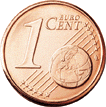
| 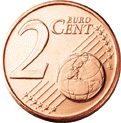
| 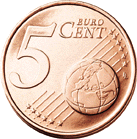
|
| €0.10 | €0.20 | €0.50 |
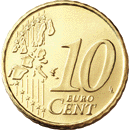
| Missing image 20c_comm.png image:20c_comm.png | 
|
| €1.00 | €2.00 | |
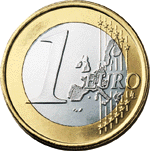
| Missing image 2e_comm.png image:2e_comm.png |
Each country participating in the euro has its own design on the national side of the coin. These designs vary from simply depicting the same design on all coins (e.g. Belgium) to a different design for every coin (e.g. Italy). However, all coins again feature 12 stars in some way or another on this side as well. To view each country's national sides, please choose from the links below, which are listed in the order preferred by the European Central Bank (alphabetically by their names in their native languages).
| Types of Euro coins | |
|---|---|
| Eurozone: | Austria | Belgium | Finland | France | Germany | Greece | Ireland | Italy | Luxembourg | Netherlands | Portugal | Spain</small> |
| New EU countries: | Estonia | Lithuania | Slovakia |
| Other: | Monaco | San Marino | Vatican |
Though they are not members of the EU, Monaco, San Marino and Vatican City (but not Andorra) also have euro coins featuring a national side, but these only occasionally end up in general circulation as their scarcity leads to greater interest from coin collectors.
The coins from Monaco feature the royal family's coat of arms and seal and the portrait of the late ruler, Prince Rainier III. Future coins will presumably feature the current ruler, Prince Albert II.
Those from San Marino have various towers and public buildings from the small nation on them as well as the national coat of arms and the Vatican coins present the portrait of the late Pope John Paul II. Future coins will feature his successor, Pope Benedict XVI. Having coins with the effigy of a religious leader accepted as legal tender caused some controversy in certain countries such as France.
As for Andorra, it has secured the right to mint its own national reverse from the EU since the country will join the EU tax evasion system in 2005. For the time being, the authority to mint coins has been transferred from the Bishop of Urgell to the Andorran government recently.
The coins were minted in several of the participating countries, many using blanks produced at Birmingham Mint, Birmingham, England. A problem has arised in differentiation of coins made using similar blanks and minting techniques. The Turkish 1 Lira coin resembles very much the 2 Euro coin in both weight and size, and both coins seem to be recognised and accepted by slot machines as being a 2 Euro coin, which is roughly worth 4 times more.
Fantasy coins
Private agencies (e.g. International Numismatic Agency in the United Kingdom or Europ-Mint in Switzerland) have created some fantasy euro coins intended for sale to collectors, both for the EU countries outside the European Monetary Union (e.g. Cyprus, Malta, Sweden) and some other European countries (e.g. Andorra, Switzerland, Liechtenstein, Norway) and territories (e.g. Corsica, Crete, Gibraltar, Guernsey, Jersey). None of these coins are legal tender anywhere.
Gold and silver commemorative issues
Suomi_10euro.jpg
A legacy of old national practice is the minting of silver and gold commemorative coins. Unlike normal issues, these coins are not legal tender in all the eurozone, but only in the country where the coin was issued. For instance, a €10 Finnish commemorative coin cannot be used in Belgium.
Despite this, these coins are not really intended to be used as means of payment, so it does not constitute a serious problem.
It is uncertain whether the Council of Ministers will grant them legal tender status elsewhere outside national boundaries, as San Marino, Monaco and Vatican City also issue these kind of coins.
Design changes
No further changes will be made to the common side of the coins until 2007 at the earliest. It is expected that eventually the 10 new E.U. members will be added to the common face of the euro coins (they are out of date since 1 May 2004).
Member states must keep their national reverse for five years. There are some exceptions, though. If the head of state of a country dies or abdicates, coins depicting the new one may be minted.
There are no plans to move to common reverse issues in the near future.
€2 Commemorative issues
The European Commission allowed the minting of commemorative coins from late 2003. From that time any eurozone country may issue commemorative €2 coins. Such coins are legal tender throughout the eurozone.
2004_Vatican_City_2_Euro_.jpg
Greece was the first country to issue this kind of coin. The €2 coin commemorates the 2004 Olympic Games. See Greek euro coins for more details.
Finland issued a €2 commemorative coin, celebrating the entry of the 10 new member states to the European Union on 1 May 2004. See Finnish euro coins for more details.
Luxembourg issued a €2 commemorative coin with the monogram of the Grand Duke.
Other countries that will issue this kind of coins include Austria, San Marino (Borghesi – October 2004), Italy – FAO ("World Food Program") and Vatican City (St.Peter's / Vatican Basilica).
In 2005, Belgium and Luxembourg will issue a joint € 2 commemorative coin, with the pictures of the Belgian king and the Grand Duke of Luxembourg on the reverse.
Refer to these countries' coin pages for further information.
Small denomination coins
Finland does not use the one and two cent coins in circulation. The Netherlands have also considered decommissioning the 1- and 2-cent coins, pressured by the retail business who claim dealing with 1- and 2-cent coins costs them too much money. In May 2004, shops in Woerden have run tests in which all cash transactions were rounded to the nearest five cent amount. Because of the positive results of the test, retailers in the whole of The Netherlands are permitted to round cash transactions to the nearest 5 cents since September 2004. The coins will both remain a valid method of payment.
Nevertheless, if a country decides not to mint these denominations, coins from other member states would remain legal tender. This is the case in Finland and The Netherlands in present times.
However, as the "foreign" monetary mass is lower than the internal, the number of 1- and 2-cent coins would stay marginal, hencefore, not being a great concern for most retailers.
Because Finland does not use 1- and 2-cent coins in circulation, but has still minted them, these coins are greatly valued in collector circles. Finnish 1- and 2-cent coins in good condition can be priced at almost one thousand times their face value.
External links
- European Central Bank (www.euro.ecb.int) (http://www.euro.ecb.int/)
- Euro Coinage (http://www.eurocoinage.info/) (Coinage of each European member states)
- Euro Coins (http://www.eurocoins.co.uk/) (including design fantasies for the UK, Denmark and Sweden)
- Official UK government website with advice for travellers (http://www.euro.gov.uk)
- Euro Coins (http://www.coins-and-banknotes.com/) (www.coins-and-banknotes.com)
- Euro Coin.net (http://www.euro-coin.net/) (gold and silver issues)
- euroswapper (coin collector swap service) (http://www.euroswapper.com)
- euobserver.com: Euro coins to show enlargment states (http://www.euobserver.com/?sid=9&aid=19075)
Newsgroups:
eo:Eŭro-moneroj it:Monete Euro lb:Euromënzen nl:Euromunten ja:ユーロ硬貨 ro:Monede euro ru:Монеты евро sv:Euromynt
